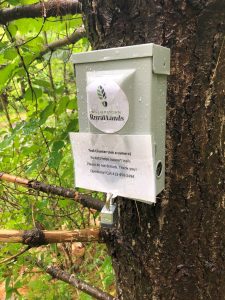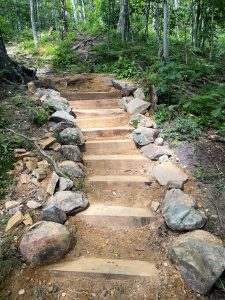By Ellie Davis, 2023 Summer Trail Intern for WRL
Williamstown Rural Lands recently invested in a new data collection system with the purchase of three trail counters that will shed light on the volume of foot traffic on the network of trails in Williamstown. This new data will inform how the land trust will choose to maintain the community’s trails for years to come.

In early summer, WRL placed the three trail counters at select sites: the well-known Pine Cobble Trail, a path at Sheep Hill adjacent to the WRL office, and the Lehovec Trail along the Green River off of Cole Avenue. Putting a trail counter on Pine Cobble was “an obvious choice because it’s the most well-known trail in town,” Stewardship Director Dan Gura said.
During seven weeks this July-August, Pine Cobble saw the most traffic with an estimated 501 people passing (assuming they came and went via the same trail), for an average of 11 hikers per day. The exact number of people who hike Pine Cobble remains hard to pin down since some people continue on to the Long Trail or Appalachian Trail. The majority of these hikers pass the trail counter between the hours of 9:00 am and 12:00 pm, and most commonly on a Saturday.
At Sheep Hill, we had on average 69 trail-walkers per week, 11 per day. This excludes the 171 counts of kids running to-and-fro during summer nature discovery program weeks, such as Sheep Hill Scientists camp. Estimated use of the Lehovec trail was modest at 11 visitors per week, 2 per day.
The trial counters contain no camera and instead use an infrared sensor that captures no images to track when someone passes by on foot. The counters store the data until someone from WRL comes by to download it.
Executive Director Robin Sears explained that after coming to WRL a little over a year ago, she learned how much the organization had done to preserve open space and provide public access to nature, though they didn’t have data on the level of trail usage in Williamstown. “I started thinking, let’s figure out how to assess our impact,” she said.
The idea for the trail counters emerged as Sears developed a grant proposal to the Wild East Action Fund through the Appalachian Trail Conservancy. “I centered the grant proposal on assessing impact,” Sears said. “The trail use is one measure of impact.”
As Sears pointed out, “Grant funders are keen to know the impact of their contribution.” The data from the trail counters will help the organization demonstrate the number of people it reaches by providing public access to natural lands.
The number of people using each trail will also inform WRL’s decisions about future trail management. “The trail counter program will help us put resources where they are needed the most,” WRL Trails Committee Chair Cosmo Catalano said. Knowing the high volume of people traversing Pine Cobble – observed knowledge confirmed by the trail-counter data – Gura and his trail crew spent much of their time this summer working on adding staircases to the trail on some of its most-eroded sections.

The Lehovec Trail also presents a unique opportunity to assess the impact of trail management. Right now, the trail is muddy, not obviously accessible, and is “madly covered with invasive plants,” as Sears pointed out. Since the trail is used only moderately, despite its close proximity to one of the most densely populated areas in Williamstown, WRL could invest in improving the trail by clearing invasives, adding board walks over muddy sections, and making the access points of the trail more obvious. Documenting increased use of the trail after such improvements could provide an encouraging example of how trail work improves nature’s accessibility.
Sears views each data point as a person made happier through being in nature: “For every person counted on those trails, I think there’s a little bit more happiness and wellness in the world.”
